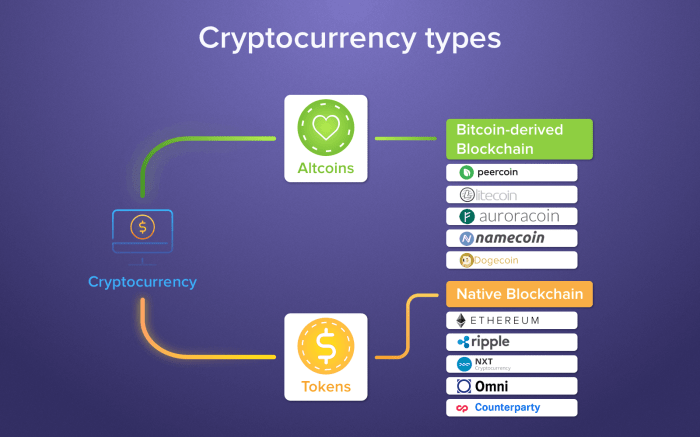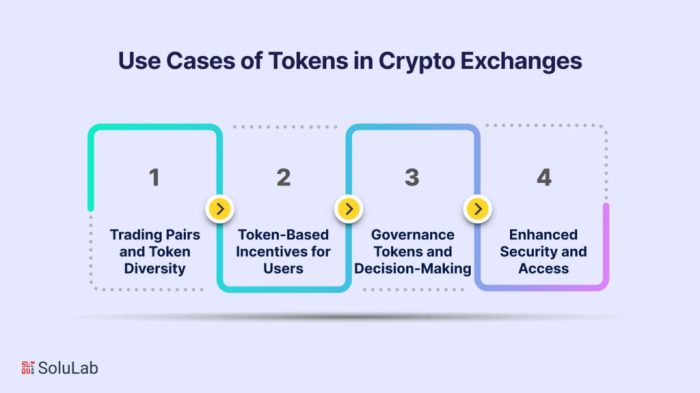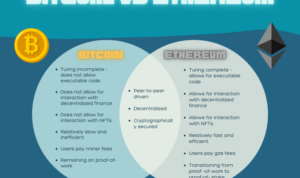The Function of Tokens in the Crypto Ecosystem sets the stage for a deep dive into the world of digital assets, unveiling the power and utility behind these virtual currencies that drive the blockchain revolution.
From representing assets to enabling decentralized applications, tokens play a crucial role in shaping the future of finance and technology.
The Role of Tokens in the Crypto Ecosystem

Tokens play a crucial role in the crypto ecosystem, serving as the building blocks of various blockchain networks. These digital assets are used to represent a wide range of assets or utilities in the digital world, enabling the transfer of value and execution of smart contracts.
Types of Tokens
- Utility Tokens: These tokens provide access to a specific product or service within a particular blockchain platform. They are used for transactions and interactions within the network, such as in decentralized applications (dApps).
- Security Tokens: These tokens represent ownership of assets, similar to traditional securities like stocks or bonds. They are subject to regulations and are used for investment purposes.
- Stablecoins: These tokens are designed to minimize price volatility by pegging their value to a stable asset like fiat currency or commodities. They are often used for trading and hedging in the crypto market.
Examples of Popular Tokens
- Bitcoin (BTC): The first and most well-known cryptocurrency, Bitcoin serves as a store of value and a medium of exchange in the crypto space.
- Ethereum (ETH): The native token of the Ethereum blockchain, ETH is used for paying transaction fees and executing smart contracts on the platform.
- USD Coin (USDC): A stablecoin pegged to the US dollar, USDC is widely used for trading and remittances due to its stability.
- Binance Coin (BNB): BNB is the native token of the Binance exchange, offering discounts on trading fees and participating in token sales on the platform.
Tokenomics

Tokenomics refers to the economics and mechanics behind a token within the crypto ecosystem. It plays a crucial role in determining the value and usage of tokens, influencing how they are distributed, circulated, and utilized within a project or platform.
Importance of Tokenomics
Tokenomics is essential as it determines the supply, demand, and overall value of a token. It helps establish a framework for how tokens will be distributed, incentivizing users to participate in the network and contribute to its growth. A well-designed tokenomics model can drive adoption, increase liquidity, and create a sustainable ecosystem for the project.
Token Supply and Distribution
- Token supply: The total amount of tokens that will ever exist. It can impact the scarcity and value of a token, with limited supply often leading to higher demand and value.
- Token distribution: How tokens are allocated and distributed among stakeholders, including investors, developers, and users. Fair and transparent distribution can build trust and credibility within the community.
Successful Tokenomics Models
- Proof of Stake (PoS): A model where users can stake their tokens to validate transactions and earn rewards. This incentivizes holding tokens and participating in network activities, enhancing security and decentralization.
- Utility Tokens: Tokens that provide access to a platform’s products or services. By creating demand for these tokens, projects can ensure their value and usage within the ecosystem.
- Token Burning: A mechanism where tokens are permanently removed from circulation, reducing supply and potentially increasing the value of existing tokens. This can create scarcity and drive up demand.
Token Utility and Use Cases
Tokens in the crypto ecosystem serve a variety of purposes beyond just investment. Let’s explore how tokens are used for voting, governance, staking, rewards, accessing dApps, and real-world applications.
Voting and Governance, The Function of Tokens in the Crypto Ecosystem
Tokens can be used for voting on important decisions within a blockchain network or a project. Holders of tokens can participate in governance processes and have a say in the direction of the platform.
Staking and Rewards
- Staking involves holding tokens in a wallet to support the network’s operations. In return, stakers are rewarded with additional tokens or other benefits.
- Rewards can be distributed to token holders based on their contribution to the network, encouraging active participation and engagement.
Access to dApps
Tokens are often required to access decentralized applications (dApps) running on blockchain platforms. Users need to hold a certain amount of tokens to interact with and use these applications.
Real-World Applications
- Example 1:
Project X utilizes its native token for users to access premium features and services on its platform.
- Example 2:
Company Y rewards customers with tokens for their loyalty, which can be redeemed for discounts on future purchases.
Token Standards: The Function Of Tokens In The Crypto Ecosystem

When it comes to token standards in the crypto ecosystem, two of the most popular ones are ERC-20 and ERC-721. These standards play a crucial role in defining how tokens are created, managed, and used within blockchain platforms.
ERC-20
ERC-20 is a widely adopted token standard that defines a set of rules and functionalities for creating fungible tokens on the Ethereum blockchain. Fungible tokens are interchangeable with each other and have the same value, making them ideal for representing currencies, commodities, or other assets.
- ERC-20 tokens are easily transferable and can be traded on cryptocurrency exchanges.
- They follow a common set of functions, such as balanceOf, transfer, and approve, making them compatible with various wallets and decentralized applications (dApps).
- Projects like Chainlink (LINK) and Binance Coin (BNB) are examples of tokens that adhere to the ERC-20 standard.
ERC-721
On the other hand, ERC-721 is a token standard that focuses on creating unique and non-fungible tokens (NFTs) on the Ethereum blockchain. Each ERC-721 token is distinct and has a specific value or attribute, making them ideal for representing digital collectibles, art pieces, or in-game assets.
- ERC-721 tokens provide ownership and provenance tracking, allowing for the creation of rare and one-of-a-kind digital assets.
- They are not interchangeable, which adds scarcity and uniqueness to each token.
- CryptoKitties and Decentraland are examples of projects utilizing the ERC-721 standard for creating unique digital assets.
Comparison and Impact
In terms of fungibility, ERC-20 tokens are interchangeable, while ERC-721 tokens are unique and non-interchangeable. The choice between these standards depends on the type of token being created and its intended use case. While ERC-20 tokens are ideal for representing currencies or tradable assets, ERC-721 tokens are better suited for creating digital collectibles or unique assets.
The use of different token standards can impact interoperability within the crypto ecosystem. Projects that utilize the same token standard can easily interact with each other, simplifying token transfers and integrations across platforms. Token standards also play a crucial role in the ease of token creation, as developers can leverage existing standards to create new tokens with specific functionalities.
Overall, token standards like ERC-20 and ERC-721 provide a framework for creating and managing tokens on blockchain platforms, offering versatility and customization options for a wide range of use cases within the crypto ecosystem.

